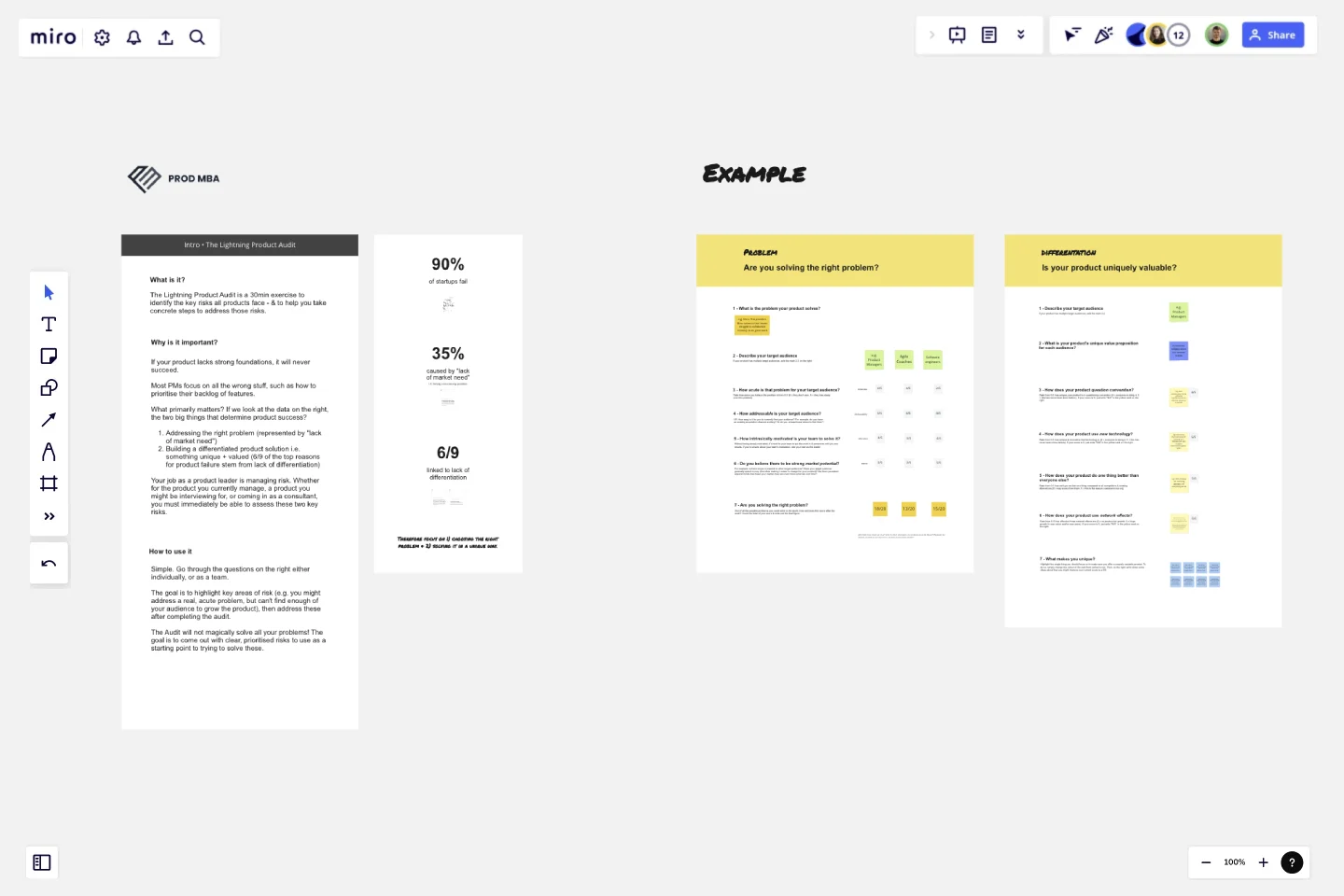The Lightning Product Audit
The Lightning Product Audit is a 30min exercise for Product Managers/Leaders to identify the key risks all products face - & to help you take concrete steps to address those risks.
Why is it so important?
If your product lacks strong foundations, it will never succeed.
Most PMs focus on all the wrong stuff, such as how to prioritize their backlog of features.
What primarily matters? If we look at the data on the right, what are the two big things that determine product success?
Addressing the right problem (represented by "lack of market need")
Building a differentiated product solution i.e., something unique + valued (6/9 of the top reasons for product failure stem from lack of differentiation)
Your job as a product leader is managing risk. Whether for the product you currently manage, a product you might be interviewing for, or coming in as a consultant, you must immediately be able to assess these two key risks.
This template was created by Prod MBA.
Get started with this template right now.
Persona Empathy Map & Canvas
Works best for:
Product Management, Empathy Map
The Persona Empathy Map & Canva by Sophie RAOUL template helps you delve deep into your customers' minds. Create comprehensive personas and empathy maps to better understand your audience's thoughts, feelings, and behaviors. This tool is perfect for developing customer-centric products and marketing strategies. Ideal for UX designers, marketers, and product managers aiming to enhance user experience.
Design Research Template
Works best for:
UX Design, Design Thinking, Desk Research
A design research map is a grid framework showing the relationship between two key intersections in research methodologies: mindset and approach. Design research maps encourage your team or clients to develop new business strategies using generative design thinking. Originally designed by academic Liz Sanders, the framework is meant to resolve confusion or overlap between research and design methods. Whether your team is in problem-solving or problem space definition mode, using a research design template can help you consider the collective value of many unrelated practices.
T-Chart Template
Works best for:
Ideation, Operations, Strategic Planning
T-Charts can help you compare and contrast two different ideas, group information into different categories, and prove a change through “before” and “after” analysis. T-Charts are visual organizational tools that enable you to compare ideas, so you can evaluate pros and cons, facts and opinions, strengths and weaknesses, or big-picture views versus specific details. Designers and content creators can use T-Charts to turn possibilities into actionable ideas. T-Charts are useful for discussing differences and similarities with your team or clients and can help you to reach a decision together.
UML Class E-Commerce System Template
Works best for:
UML
The UML Class E-Commerce System Template streamlines the process of creating and visualizing the class structure of an e-commerce system. It provides a comprehensive framework that includes typical online shop features such as product listings, inventory management, shopping carts, orders, payments, and shipping details. This template facilitates a clear understanding of how these elements interact during an online sales transaction, making it an invaluable tool for teams working on e-commerce projects. By using this template, teams can save time, enhance collaboration, and ensure that their system architecture is robust and efficient, ready to adapt to their business's evolving needs.
Design Brief Template
Works best for:
Design, Marketing, UX Design
For a design to be successful, let alone to be great, design agencies and teams have to know the project’s goals, timelines, budget, and scope. In other words, design takes a strategic process—and that starts with a design brief. This helpful template will empower you to create a brief that builds alignment and clear communication between your business and your design agency. It’s the foundation of any creative project, and a single source of truth that teams can refer to all along the way.
Product Strategy Canvas
Works best for:
Product Management, Planning
The Product Strategy Canvas template aids product managers in defining strategic direction and priorities. By outlining key components, such as target markets, value propositions, and differentiation strategies, this template clarifies product vision and positioning. With sections for analyzing market trends and competitive landscapes, it facilitates informed decision-making in product strategy development. This template serves as a strategic blueprint for driving product success and achieving business objectives.
